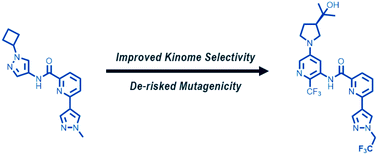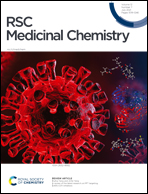Optimization of brain-penetrant picolinamide derived leucine-rich repeat kinase 2 (LRRK2) inhibitors†
Abstract
The discovery of potent, kinome selective, brain penetrant LRRK2 inhibitors is the focus of extensive research seeking new, disease-modifying treatments for Parkinson's disease (PD). Herein, we describe the discovery and evolution of a picolinamide-derived lead series. Our initial optimization efforts aimed at improving the potency and CLK2 off-target selectivity of compound 1 by modifying the heteroaryl C–H hinge and linker regions. This resulted in compound 12 which advanced deep into our research operating plan (ROP) before heteroaryl aniline metabolite 14 was characterized as Ames mutagenic, halting its progression. Strategic modifications to our ROP were made to enable early de-risking of putative aniline metabolites or hydrolysis products for mutagenicity in Ames. This led to the discovery of 3,5-diaminopyridine 15 and 4,6-diaminopyrimidine 16 as low risk for mutagenicity (defined by a 3-strain Ames negative result). Analysis of key matched molecular pairs 17 and 18 led to the prioritization of the 3,5-diaminopyridine sub-series for further optimization due to enhanced rodent brain penetration. These efforts culminated in the discovery of ethyl trifluoromethyl pyrazole 23 with excellent LRRK2 potency and expanded selectivity versus off-target CLK2.

- This article is part of the themed collection: NeuroMedChem


 Please wait while we load your content...
Please wait while we load your content...